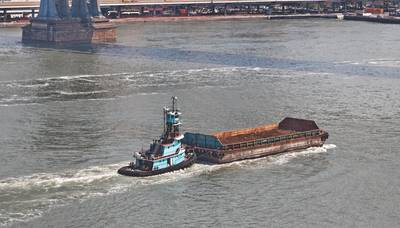Where commercial marine and safety considerations allide with recreational and other peripheral agendas, the discussion can sometimes be contentious. One such example of this reality is now playing out on the Hudson River in New York.
On June 9, 2016, the U.S. Coast Guard published a three-page Federal Register notice, seeking public comments on a proposal suggesting new anchorage grounds in the Hudson River, from Yonkers to Kingston, N.Y. Officially, this was an advance notice of proposed rulemaking; in other words, an action the Coast Guard was more or less thinking about, but, still an idea sufficiently developed to check public interest and concern.
In fact, that three-page notice produced a landslide of concern, much of it critical. When the public comment period closed in December, the CG had received more than 10,000 comments. U.S. Rep. Sean Patrick Maloney (NY-18), whose district straddles the Hudson, halfway between New York City and Albany, sent a file with more than 400 pages of constituents’ comments.
What’s the Big Deal?
Anchorage grounds are not usually contentious. And the river sections referenced within the FR notice have long been used as safe harbors, although never formally designated as such. In fact, reports of unauthorized vessel ‘parking’ are what started this complex mix of issues. In 2015, in response to those reports, CG Section New York, issued a mariners’ Bulletin reminding captains that anchorage is only allowed in authorized, federally designated locations.
That Bulletin prompted a January, 2016, request from The Maritime Association of the Port of New York/New Jersey Tug & Barge Committee, the Hudson River Port Pilot’s Association and the American Waterways Operators (AWO). The appeal: we need additional anchorage grounds, since just one exists within the 109 nautical miles from Yonkers to the Port of Albany. Mariners suggested the customary anchorage sites already in use: 10 sites, providing for up to 43 vessels. The Coast Guard carried these suggestions forward.
For mariners, this was about safety, for crews and vessels and, indeed, the river itself. For critics, the CG’s proposal was seen as a cave-in, allowing behind the scenes self-interest to risk an environmental tipping-point in conflict with the broader public interest. Again, anchorage grounds are mostly ho-hum topics. The Hudson River has been an industrial, commercial river for centuries. What happened? Why did a seemingly straightforward proposal go viral?
NIMBY
“Not-in-My-Backyard” NIMBY-ism accounts for some opposition. Critics worry that new anchorage sites mean inevitable increases in river traffic and attendant risks, from spills to accidents to concerns about public drinking water. Some people comment that barge and river traffic are part of a maritime industrial economy that New York should let decline, not seek to advance. Some critics reference “view-sheds” and how barges and tanker operations detract from the value of a more pastoral river. But the mariners themselves introduced the real hot-button issues: oil, particularly, notorious Bakken oil.
In their January, 2016 letter, the Tug & Barge Committee predicted that “trade will increase on the Hudson River significantly over the next few years.” Why? Because of ever-increasing amounts of Bakken oil, arriving via rail at the Port of Albany. Stakeholders go on to say, “the great port of Albany (will be) a leading export port for American Bakken Crude Oil and Ethanol.” That’s potentially unsettling stuff, especially for a general public which traditionally has little sense of the importance of commercial marine commerce.
The issue of oil – its transport, possible spills and the qualities of Bakken crude – came to dominate and link opponents’ concerns. Critics charged that the river’s 43 new anchoring zones, all but one listed for “long term usage”, could become a logistical tool for oil markets. Rather than just transport significantly increasing quantities of oil, opponents asked whether the new anchoring sites might be used to park and store oil, either waiting for distant terminals to open-up or perhaps awaiting price increases to control when the oil finally moved.
Commercial Stakeholders Speak up
Edward Kelly is Executive Director of the Maritime Association of the Port of NY/NJ. Kelly asserts that fears about oil shipments are deliberately exaggerated, since barge transport is the safest way to move crude. He says there are groups who need scare tactics to advance other agendas; climate change, for example. Regarding oil-barge storage, Kelly said that Bakken is a relatively expensive crude; it’s not in constant demand from timely price signals. Most importantly, the costs of storing oil on a barge, with a full crew and a tug constantly on duty, completely undercut any economic benefits. For Kelly, the anchorage, first and foremost, is about safety. But he concedes, “Unfortunately, the people in our Tug & Barge Committee possibly ‘oversold’ the movement of southbound crude oil.”
Interestingly, a closer look at the Port of Albany’s operations shows that the Port has not handled any crude oil for the last two years. Within Port facilities, there haven’t been any moves towards intermodal crude. Some facilities outside the Port have changed their oil operations but much of that work involved safety and environmental upgrades, not dramatic increases in shipments.
A second energy issue bedevils this topic: the Champlain Hudson Power Express (CHPE) – a proposal to build a 320kV electric transmission cable from Quebec to New York City. Cables, of course, commonly cross underneath rivers. The CHPE cable, however, will run length-wise below the Hudson, for 88 miles, mostly buried but held down by cement “blankets” in sections of impermeable bedrock. This is a game-changer where timing is concerned. Mariners need decisions about safety zones now, not after a submerged cable likely ends the discussion.
The CHPE project reportedly links to hydro or maybe nuclear generation – whichever, a rumor of non-carbon, non-fossil electricity. For many anchorage grounds opponents, this (possibly) green power source gives it a pass, gives it precedence over shipments of dirty oil. Green power is the future, asserts this bias; oil is the fading economy. Therefore, many commenters assert, if the Hudson must be impacted, a so-called green power project delivers greater public benefit than a move with links to oil.
Ironically, anchorage grounds critics don’t usually include that the CHPE project is a private project. It was not advanced by public sector or public utility commission experts, a policy shortcoming cited by many who oppose new anchorage grounds. CHPE is a merchant project seeking to sell power within New York City’s electricity market. In reality, CHPE needs the Hudson for energy transport even more than the mariners need anchorage grounds to help with possible energy transport. Without a private right-of-way through the Hudson River, CHPE stops.
CHPE’s permit was approved by the Army Corps in 2015. It is a difficult permit, with demanding terms and conditions, including a “navigation risk assessment” and an “anchor snag manual,” neither of which is finished. The permit’s initial expiration was 2019, now extended to 2021. In-water work has not started. How that assessment has progressed and where it stands now is difficult to determine.
Can This Proposal be Saved?
LT Karen Love Kutkiewicz is the Public Affairs Officer with the First Coast Guard District based in Boston. She said CG officials were surprised that the anchorage proposal went viral. But she adds, “We deliberately sought that wide comment last June. We are aiming for a transparent federal government.”
Kutkiewicz said that federal law requires an environmental impact statement. For the Coast Guard, core issues include safety, the environment and the fact that this is a request from a private sector group. Kutkiewicz was not aware of the CHPE cable project and parallel issues, such as the anchor snag manual, for example. She forwarded CHPE questions to a colleague.
Edward Kelly, with the Maritime Association, remains confident that the Coast Guard will vet the matter deliberatively and fairly. He noted that many of the 10,000 comments are just copied, duplicative remarks. And he said, “They [the Coast Guard] are not in charge of converting America to non-fossil fuels.” Kelly expects some sort of preliminary finding by April, with public hearings likely in the fall. It’s possible that mariners won’t get everything they asked for, but Kelly is confident that this will be a set of decisions based on issues pertaining to safe transportation, the central issue for all anchorage grounds.
As a minimum, the process is worth watching closely, as it represents a perfect example of how commercial marine traffic coexists – hopefully – with recreational and non-maritime interests, on the nation’s waterways and in its many ports.
The Author
Tom Ewing is a freelance writer specializing in energy and environmental issues.
(As published in the April 2017 edition of
Marine News)













